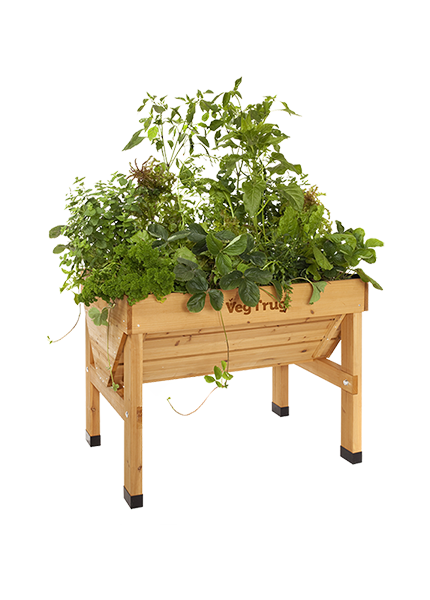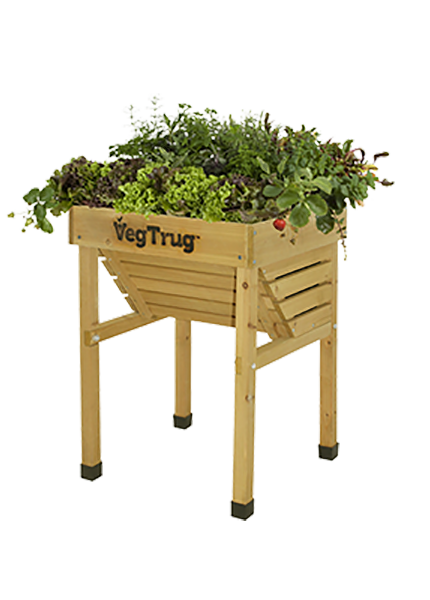Tomatoes generally come in two different growth habits, Cordon (or indeterminate) tomatoes grow tall, reaching up to 1.8m (6ft) and require support. Bush (or determinate) tomatoes are bushy and are great for smaller gardens and pots - or a VegTrug.
Read more on how to grow Tomatoes below.
Tomatoes are easy to grow from seed and a quick check of the packet will tell you if the tomatoes are right for your space. If you are growing the plants outdoors, you can sow seed from early spring. If you are planning on growing your tomatoes in a greenhouse, you can start sowing seed earlier.
Sow in small pots indoors, using a propagator or place the pots in a plastic bag and keep on the windowsill. The young seedlings need to be kept at around 18°C (64°F). Transplant into 9cm (3½in) pots when two true leaves have formed.
Young plants are available from garden centres in spring if you don’t have the space to raise tomato seedlings. But they will still require frost-free conditions and hardening off before planting outside.
Once you know the fundamentals of how to grow tomatoes, it’s pretty straightforward to enjoy a season of this healthy fruit.
When the flowers of the first truss, the stem that bears the flowers, begin to open, transfer to 23cm (9in) pots, growing bags or plant 45-60cm (18-24in) apart outside. Plants for growing outdoors should be hardened off first.
For cordon tomatoes, tie the main stem to a vertical bamboo cane or wind it round a well-anchored but slack sturdy string. Remove the side shoots regularly when they are about 2.5cm (1in) long.
When eventually plants reach the top of the greenhouse or have set seven trusses indoors or four trusses outdoors, remove the growing point of the main stem at two leaves above the top truss.
Those grown as bush or hanging basket types do not need support. You won't need to remove side shoots.
Water your plants regularly to keep the soil/compost evenly moist. Fluctuating moisture levels can cause the fruit to split. Feed every 10-14 days with a balanced liquid fertiliser, changing to a high potash one once the first fruits start to set. Irregular watering, together with a lack of calcium in the soil leads to blossom end rot - the bottom of the fruit turns black and becomes sunken.
For indeterminate (vine or cordon tomatoes), there is evidence that removing some leaves above the ripening truss (which allows the fruit to be warmer during the day but cooler at night) can encourage slightly earlier ripening without negatively affecting cropping. Removing leaves below the ripening truss does not improve ripening but can help reduce the spread of diseases such as tomato leaf mould or tomato blight where these are a problem.
Blossom end rot, tomato leaf mould and tomato blight are all problems that you might come across when learning how to grow tomatoes.
Blossom end rot shows as dark, leathery sunken patches at the bottom of the fruit and is caused by a lack of calcium. Tomato leaf mould is rare on plants grown outdoors, but on indoor grown plants is found as yellow blotches on the upper part of the leaf with grey mould underneath. Blight rots the fruit.
You might also spot whitefly on indoor tomatoes.
In general tomatoes are easy to grow and creating good conditions, including proper spacing and regular watering can help prevent problems.
Proper watering and feeding correctly will stop the tomatoes from splitting too.
Tomatoes do the best when they are left on the plant to ripen. Eating them straight from the vine delivers the best taste too. The smaller varieties will ripen faster than the larger ones, and tomatoes grown in greenhouses will also ripen quicker than those grown outdoors.
Tomatoes don’t freeze well, but can be kept at room temperature for a week or so. Keeping your fresh tomatoes in the fridge for too long can affect the taste, so pick and eat straight away as much as you can.
How to grow tomatoes is part of the VegTrug Grower’s Guide.

